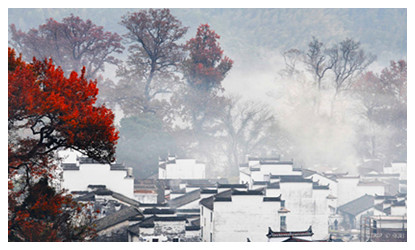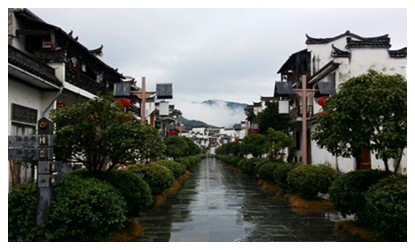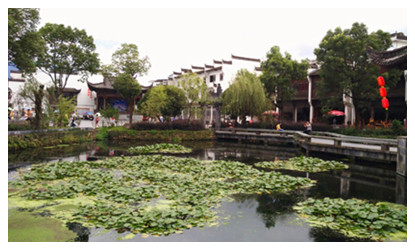- Home
- Travel In China > China Attractions > Jiangxi Attractions >
Jiangwan Ancient Village
Jiangwan Village lies 28 kilometers away from Wuyuan County in Shangrao City, Jiangxi Province. As one of the top attractions in Wuyuan, Jiangwan Village is just like an emerald inlaid in the verdant valley,which is embraced by rolling mountains from three sides – Ling Mountain in the east, You Mountain in the south, and Back Dragon Mountain to the north.
History of Jiangwan Vilage
First built during the Tang Dynasty (618-907), it preserves a large number of rare and ancient residences with
Huizhou architectural style. It is regarded as the hometown of books because there were lots of talented people and famous officials in this village from the Song Dynasty to Qing Dynasty (960-1911). From the time of the Tang Dynasty it is estimated that 38 high officials came from this town, all of whom chose to build large residences in order to improve life-quality of their families, resulting in many well preserved official mansions and houses of merchants. Nowadays, it is gaining popularity among local people and tourists and has even achieved the national 5A level scenic spot.
What to see?
 An S shaped river runs east to west through this village. The advantageous location of this village endows the whole scenic area with a mild and moist climate, as well as pleasant scenery. The natural scenery and simple country life attracts more and more tourists and photographers. This village has abundant cultural heritages. Nineteen scholars and 92 representative literature works are proof of this Scholarly Village. Among these literature works, fifteen were included in Four Authorized Books of China.
An S shaped river runs east to west through this village. The advantageous location of this village endows the whole scenic area with a mild and moist climate, as well as pleasant scenery. The natural scenery and simple country life attracts more and more tourists and photographers. This village has abundant cultural heritages. Nineteen scholars and 92 representative literature works are proof of this Scholarly Village. Among these literature works, fifteen were included in Four Authorized Books of China.
The architectural concept and layout of Jiangwan Village have its own unique characteristics. Looking from the top of Back Dragon Mountain, the streets and paths of the central part form a shape of Chinese character An, meaning peace and happiness. The old streets still have retained the elusive charm of Ming and Qing dynasties. Along the street, there are many old shops and ancient houses, such as Xiaojiang Ancestral Hall, Peixin Hall, Dunchong Hall, Sanxing Hall and Risheng Hall.
Xiaojiang Ancestral Hall, also named Eternal Think Hall, is one of the most typical and popular ancient houses in the village. First built in 1578 and after the expansion of Qing Dynasty (1644-1911), nowadays, this hall covers 2,400 square meters with royal style. Forecourt, antechamber, central hall and back hall compose four major parts of this ancestral building. The forecourt has capacious gardens with an exquisite half-moon-shaped fishpond. The antechamber contains Five Phoenix Archway, Wuchao Gate and Moon Archway. The pillars of these buildings are decorated with complicated patterns and vivid images. In the central hall, tourists can see rare inscribed boards and couplets that show the brilliant history of Jiang’s family. The purpose of these boards and couplets is to encourage descendants to work diligently. The back hall is higher than the forecourt. It enshrines memorial tablets of this family’s ancestors. Nowadays, this hall is regarded as the well-preserved one among 70 famous ancestral halls in southern area of the Yangtze River. It is also reputed as the First Hall in Wuyuan County.
 Dunchong Hall
Dunchong Hall was first built in 1865 during the Qing Dynasty (1645-1911). The formal layout and luxurious decorations of Dunchong Hall fully embodies the wealth and status of this family. Foreyard, palanquin hall, reception room and main hall connect with each other transversely. The main hall is a two-storey building that has lots of rare ancient wooden furniture. The ground is paved with numerous pebbles. These pebbles form a shape of a Chinese ancient coin, meaning to bring in wealth and happiness every year.
Liangshang Street, also known as Back Street or Official Street, is a must-see scenic spot in Jiangwan Village. This ancient street traverses the village from east to west, and connects with several small lanes the north and south. In ancient times, it flourished with lots of breweries, a tofu workshop, grocery stores and restaurants. Nowadays, tourists can buy some local products and souvenirs in this street.
 Peixin Hall
Peixin Hall is an important hall in this village. The name Peixin means to cultivate good manners in heart. It features the typical architectural style of
Huizhou, which is the first part of this house is the shop that sells local products; the central part is the living area; and the last part is the kitchen. Through the hallway, there is a square courtyard. To the south of this courtyard, there is a grand and exquisite archway engraved with many kinds of beautiful and lively patterns of animals and plants. The layout of those living rooms obeys the rule of symmetry. The central one is the main room. On the east and west sides, there are some secondary living rooms. When tourists visit this house, they will feel a quiet and peaceful atmosphere. Those who have a hectic lifestyle will enjoy this comfortable atmosphere. This kind of unique scenery and the rare cultural relics are like magic medicine to release the pressures of work and study.
Travel Tips
Add: 28 kilometers from Wuyuan County, Shangrao City,Jiangxi Province
Entrance Fees: CNY 60
Opening Hours: 08:00 -18:00 (March to November) , 8:00 - 17:30 (December to February)
 An S shaped river runs east to west through this village. The advantageous location of this village endows the whole scenic area with a mild and moist climate, as well as pleasant scenery. The natural scenery and simple country life attracts more and more tourists and photographers. This village has abundant cultural heritages. Nineteen scholars and 92 representative literature works are proof of this Scholarly Village. Among these literature works, fifteen were included in Four Authorized Books of China.
An S shaped river runs east to west through this village. The advantageous location of this village endows the whole scenic area with a mild and moist climate, as well as pleasant scenery. The natural scenery and simple country life attracts more and more tourists and photographers. This village has abundant cultural heritages. Nineteen scholars and 92 representative literature works are proof of this Scholarly Village. Among these literature works, fifteen were included in Four Authorized Books of China. Dunchong Hall was first built in 1865 during the Qing Dynasty (1645-1911). The formal layout and luxurious decorations of Dunchong Hall fully embodies the wealth and status of this family. Foreyard, palanquin hall, reception room and main hall connect with each other transversely. The main hall is a two-storey building that has lots of rare ancient wooden furniture. The ground is paved with numerous pebbles. These pebbles form a shape of a Chinese ancient coin, meaning to bring in wealth and happiness every year.
Dunchong Hall was first built in 1865 during the Qing Dynasty (1645-1911). The formal layout and luxurious decorations of Dunchong Hall fully embodies the wealth and status of this family. Foreyard, palanquin hall, reception room and main hall connect with each other transversely. The main hall is a two-storey building that has lots of rare ancient wooden furniture. The ground is paved with numerous pebbles. These pebbles form a shape of a Chinese ancient coin, meaning to bring in wealth and happiness every year. Peixin Hall is an important hall in this village. The name Peixin means to cultivate good manners in heart. It features the typical architectural style of Huizhou, which is the first part of this house is the shop that sells local products; the central part is the living area; and the last part is the kitchen. Through the hallway, there is a square courtyard. To the south of this courtyard, there is a grand and exquisite archway engraved with many kinds of beautiful and lively patterns of animals and plants. The layout of those living rooms obeys the rule of symmetry. The central one is the main room. On the east and west sides, there are some secondary living rooms. When tourists visit this house, they will feel a quiet and peaceful atmosphere. Those who have a hectic lifestyle will enjoy this comfortable atmosphere. This kind of unique scenery and the rare cultural relics are like magic medicine to release the pressures of work and study.
Peixin Hall is an important hall in this village. The name Peixin means to cultivate good manners in heart. It features the typical architectural style of Huizhou, which is the first part of this house is the shop that sells local products; the central part is the living area; and the last part is the kitchen. Through the hallway, there is a square courtyard. To the south of this courtyard, there is a grand and exquisite archway engraved with many kinds of beautiful and lively patterns of animals and plants. The layout of those living rooms obeys the rule of symmetry. The central one is the main room. On the east and west sides, there are some secondary living rooms. When tourists visit this house, they will feel a quiet and peaceful atmosphere. Those who have a hectic lifestyle will enjoy this comfortable atmosphere. This kind of unique scenery and the rare cultural relics are like magic medicine to release the pressures of work and study.
 Ask Questions ?
Ask Questions ?